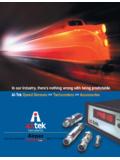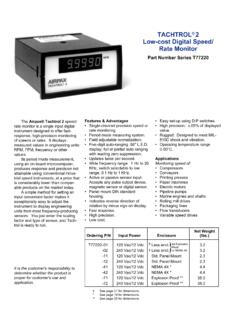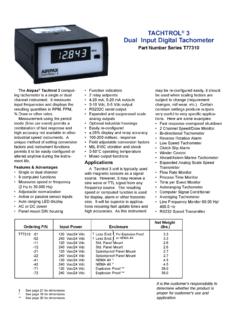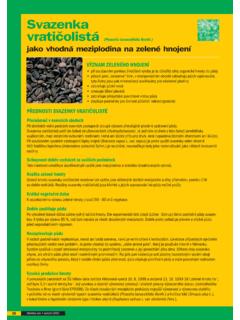Transcription of TACH•PAK Instruction Manual - aitek-usa.com
1 Airpax Instruments tach PAK 3. Instruction Manual This Manual is applicable to all tach Pak 3 models. VDO Control Systems, Inc. Table of Contents 1. 1. Overview .. 1. Tool List .. 3. How to Use this Manual .. 3. Where to Go for Help .. 4. 2. Unpacking Instructions .. 5. Package Contents .. 5. Unpacking .. 5. 3. Mounting and Wiring Procedures .. 6. Installation and Wiring Guidelines .. 6. Mounting tach -PAK 3 .. 7. Mounting the Speed Sensor .. 8. Wiring Connections .. 9. Accessing the Terminal 9. Terminal Block Assignments .. 10. Types of Speed Sensors .. 11. Connecting a Passive Sensor .. 11. Connecting an Active Sensor .. 12. Optional Circuits .. 12. Connecting the AC Power Supply .. 13. Connecting a DC Power Supply .. 15. Dual Power Supplies.
2 15. 4. Control Panel / Display .. 1 6. Scientific Notation .. 16. 5. Characteristics of Operation .. 1 7. The Constants .. 17. Constant Descriptions .. 17. Meter Full Scale Frequency (FS) .. 18. Display Format for Meter Full Scale Frequency .. 18. Determining Meter Full Scale Input Frequency .. 18. Analog Zero Scale Frequency (A0) .. 19. Display Format for Analog Zero Scale Frequency .. 19. Determining Analog Zero Scale Input Frequency .. 19. Analog Full Scale Frequency (AF) .. 20. Display Format for Analog Full Scale Frequency .. 20. Determining Analog Full Scale Input Frequency .. 20. Special Constant (SP) .. 22. Display Format for Special Constant (SP) .. 22. Lowest Measured Frequency (time-out).. 22. Calibrate Frequency (CF) .. 23. Display Format for Calibrate Frequency.
3 23. Setpoint Classifications .. 24. Failsafe 24. Non-failsafe Setpoint .. 24. Setpoint Categories .. 24. Overspeed setpoint .. 24. Underspeed 24. Illustrations of setpoint types .. 25. Setpoint types .. 26. Display Format for Setpoint Frequency (S1 through S4).. 26. EA (Energize Above setpoint).. 26. Eb (Energize below setpoint).. 27. dA (de-energize Above setpoint) .. 27. db (de-energize below setpoint) .. 27. Hysteresis .. 28. Display Format for Hysteresis and Type Constants (H1 H4) .. 28. Hysteresis bias .. 28. Hysteresis magnitude .. 28. Hysteresis types .. 28. Frequency domain hysteresis (h) .. 29. Example: Frequency domain hysteresis .. 29. Time domain hysteresis (H) .. 29. Example: Time domain hysteresis .. 30. Delayed Trip or Latching Relay (L).
4 30. Delayed Trip .. 30. Latching relay .. 31. Example: Delayed 31. Example: Latching Relay .. 31. 6. Adjustment Features .. 3 2. Entering the Constants .. 32. Analog Outputs .. 33. R1 - Meter Output Full Scale Adjusting Potentiometer .. 33. R2 - Analog Full Scale Adjusting Potentiometer .. 34. Filter Switches .. 34. SW3-1 Meter Output Filter Dip Switch .. 34. SW3-2 Analog Output Filter Dip Switch .. 34. 7. Reference .. 3 5. Specifications .. 35. Power Supply .. 35. Signal Input .. 35. Outputs .. 35. Environmental .. 36. Glossary .. 37. Target Variable Conversions .. 39. 40. Index .. 41. Recorded Stored Constants .. 43. I. Introduction tach -PAK 3 is a single-input industrial tachometer that measures the rate of events. Using various sensors, tach -PAK 3 can measure events as simple as the speed of a rotating shaft, the rate at which paper passes through a press, or as diverse as the rate at which liquid flows through a pump.
5 1 . 1 Overview A speed sensor placed near a target, such as a rotating gear, generates a repeating electrical rate of repetition is proportional to the rate of the event you want to measure and represents the input 3 measures this rate in number of pulses per second (hertz).This input signal from the sensor is conditioned, analyzed by a microcom- puter and routed to the outputs. tach -PAK 3's microcomputer uses a scheme of data acquisition called adaptive period averaging, a unique frequency measuring method in which the number of periods averaged changes with the frequency to obtain optimal accuracy. At input frequencies of 100 Hz and above, the outputs are updated every 30 milliseconds. tach -PAK 3 provides three scaleable output types: 0-1 mA DC meter output 0-20/4-20 mA DC analog output Four Form C (SPDT) relay setpoints To set up tach -PAK 3, first determine how each output should behave in your application, then enter the setup information as thirteen constants through tach -PAK 3's internal control panel.
6 (See Section 4.) The constants are stored in tach -PAK 3's electrically alterable read-only memory (EAROM).They can be viewed and altered individually in much the same way you set a digital watch. 1. Figure 1. Operation Flow Diagram To put tach -PAK 3 into operation, complete the following steps: 1. Mount tach -PAK 3 See Section 2. Install and connect the appropriate output wiring. See Section 3. Install and connect the speed sensor See Sections and 4. Install and connect the power wiring See Section or 5. Enter the constants into tach -PAK 3 See Section 6. This Manual describes all five steps. Note: By connecting temporary power wiring, tach -PAK 3 can be powered up and programmed prior to mounting it on the application. NOTE. 2. Tool List You will need the following tools to perform the procedures described in this Manual : #1 or #2 Phillips screwdriver #4 Phillips screwdriver #2 straight blade screwdriver How to Use this Manual This Manual contains the following sections: Chapter 1 - Introduction contains a brief description of tach -PAK 3.
7 Chapter 2 - Unpacking Instructions describes the package contents and proper removal of tach -PAK 3. Chapter 3 - Mounting and Wiring Procedures contains instructions for mounting the speed sensor and making the electrical connections. Chapter 4 - Control Panel/Display describes the internal control panel and display, scientific notation, the constants, the function of each constant, and how to determine its appropriate value. Examples are provided. Chapter 5 - Characteristics of Operation describes setpoints, hysteresis and how they are used by the constants to control the four relays. Chapter 6 - Entering the Constants gives procedures for how to enter and store the con- stants. Chapter 7 - Reference contains specifications, a glossary, and other technical information.
8 The Appendices contain an index and other customer information. 3. This Manual uses the following conventions: Note: provides an explanation or amplification. NOTE. Caution: advises you risk damaging your equipment if you do not heed instructions. CAUTION. Danger: advises you risk danger to personal health if you do not follow instructions carefully. DANGER. Where to Go for Help For technical support and programming assistance on this product, please contact your local distributor. To locate the distributor closest to you, please call: 1-800-643-0643. 4. 2. Unpacking Instructions To ensure safe transit every tach -PAK 3 is thoroughly tested and carefully packed before leaving the plant. Responsibility for its safe delivery was assumed by the carrier upon accep- tance of the shipment.
9 Claims for loss or damage sustained in transit must be made to the carrier. Package Contents tach -PAK 3 is shipped in a single carton that contains: one tach -PAK 3. one Instruction Manual Note: Electrical and mounting hardware are not supplied. NOTE. Unpacking CAUTION: tach -PAK 3 is a precision instrument. Although it is designed to withstand the rigors of industrial use, excessive physical shock or vibration can damage it. Handle it carefully. Do not drop or subject it to physical extremes exceeding those specified in Section CAUTION. 1. Place the carton on a level surface in a well-lighted area and open the top. 2. Carefully lift out tach -PAK 3 and the packing material. 3. Remove the packing material. 4. Remove the Instruction Manual from the carton.
10 5. Inspect your tach -PAK 3 for concealed damage. 5. 3. Mounting and Wiring Procedures Installation and Wiring Guidelines Adhere to these guidelines when installing your instrument: 1. Locate tach -PAK 3 away from sources of water, humidity, heat, and dust; or provide a suitable enclosure to protect it from these elements. 2. Locate tach -PAK 3 away from sources of electrical noise such as, but not limited to: SCRs, triacs, buzzers, horns, motors, welding equipment, contactors, heavy current relays, and other electrical noise generating equipment. 3. Use a metal enclosure to protect tach -PAK 3 from radiated electrical noise or other magnetic influences. If tach -PAK 3 is removed from its original enclosure, it should be installed only in panels or cabinets with other low level electronic devices.



